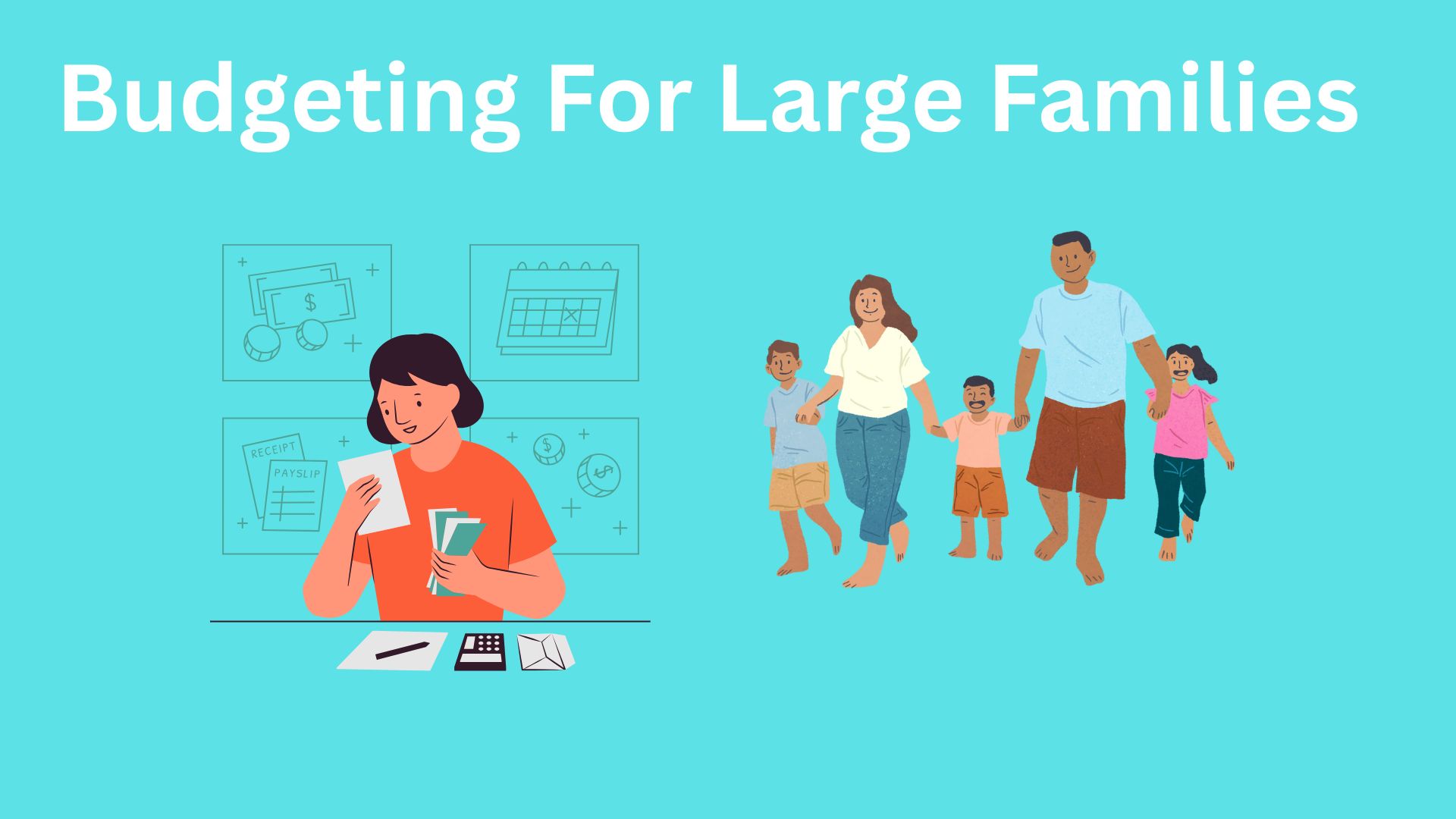Budgeting for large families is not just about spreadsheets and cutting back—it’s a daily balancing act between needs, wants, and unexpected expenses. If you’ve ever found yourself wondering how to stretch your monthly income to cover groceries, school supplies, rising utility bills, and maybe still sneak in a movie night at home, you’re not alone. Whether you’re just starting to build a budget or refining an existing one, this article will help you take control of your finances without breaking the bank.
Key Takeaways
- Start with a realistic monthly family budget based on actual income and expenses.
- Meal planning and grocery shopping strategies can significantly cut the grocery bill.
- Use budgeting apps and worksheets to track your spending and stick to a budget.
- Involve older kids in budgeting discussions to teach financial literacy early.
- Make adjustments to your budget regularly to reflect changing family needs.
Why Budgeting Matters for Large Families
According to a 2023 Pew Research Center study, nearly 1 in 5 U.S. households have three or more children under 18. These households often face higher living expenses but are less likely to maintain an emergency fund. Another study by the Bureau of Labor Statistics found that food, housing, and transportation remain the largest spending categories for families of 7 or more.
The bottom line? Budgeting isn’t just a financial tool—it’s a form of stress management, a path to long-term stability, and a powerful way to model good money habits for your children.
Understanding the Unique Financial Dynamics of Large Families
Why Traditional Budgets Often Fall Short for Big Families
A regular budget might work well for smaller households, but when you’re managing a family of 6 or 7, the complexity increases. You’re juggling higher grocery spending, more frequent utility usage, and living expenses that fluctuate wildly with each school term, growth spurt, or unexpected medical bill.
Many standard budgeting tips assume a two-parent, two-child household. But a large family budget isn’t that straightforward. You need a more flexible budgeting method that considers quantity without compromising quality.
For example, the grocery bill for a family of 7 can easily reach double the national average if not managed wisely. That’s why creating a family budget with room for bulk purchases, store loyalty programs, and fresh produce rotation is critical to avoiding overspending.
Building a Budget That Reflects Reality
The first step in budgeting for large families is knowing your monthly income and having a clear understanding of where your money is going. Start budgeting by listing all income and expenses, from fixed costs like rent or mortgage to variable costs like groceries and transportation.
To build a budget that truly reflects your needs:
- Track your spending for 30 days using a worksheet or budgeting app.
- Categorize spending into essentials, flexible costs, and savings goals.
- Use this data to make a budget that’s grounded in your actual financial behavior—not just what you hope to spend.
Don’t forget to include an emergency fund category. With more children comes more unpredictability—broken appliances, school trips, last-minute health costs—and you need a buffer.
Practical Budgeting Methods That Work for Big Families
Zero-Based Budgeting and Envelope Systems
One powerful budgeting method for large households is zero-based budgeting, where every dollar of income is assigned a job, leaving zero “idle” funds. This gives you control of your finances and ensures you’re not overspending in unnoticed areas like snack runs or entertainment.
Alternatively, try the envelope system. It’s old-school but highly effective: assign physical envelopes or digital wallets to categories like “groceries,” “clothing,” and “utilities.” Once the money’s gone, it’s gone. This helps with sticking to a budget, especially in high-spending categories like food and entertainment.
A variation of this I used when our kids were younger was having an envelope for each child’s school needs—this ensured I wasn’t caught off guard when all five needed new shoes at once.
Budgeting Apps for Busy Parents
If envelopes aren’t your style, digital budgeting apps like You Need A Budget (YNAB) or EveryDollar are great tools for managing family finances. They help you visualize spending, automate savings, and even plan for family vacations or holiday gifting.
The right app saves money not just through tracking but by helping you make adjustments in real time. For example, if your utility bills spike in a cold month, you can shift funds from entertainment or eating out to cover the difference without falling behind.
Saving on the Big Three: Food, Utilities, and Transportation
Mastering Meal Planning and Grocery Shopping
For large families, meal planning is a budget-saver. Plan meals weekly based on what’s on sale and what’s already in your pantry. This reduces waste and helps manage your grocery budget more efficiently.
Buy in bulk from Costco and Sam’s, but also shop around at local grocery stores for deals on fresh produce and dairy. Remember, feeding a big family doesn’t mean compromising on nutrition—it means planning ahead.
As a rule of thumb, we aim to spend no more than $2 per meal per person. When followed consistently, this small shift can lower our grocery bill by hundreds each month.
Trimming Utility and Transportation Costs
Utility expenses scale with the number of people in a household, so it’s crucial to monitor usage. Implement simple habits:
- Teach kids to turn off lights.
- Use energy-efficient appliances.
- Wash clothes in cold water.
We installed smart thermostats and low-flow showerheads, and the impact on our utility bills was noticeable. A family of 7 taking shorter showers adds up to real savings.
For transportation, consider carpooling, consolidating errands, and maintaining your vehicle regularly. Preventive maintenance can save money long-term and reduce emergency repair costs.
Getting the Whole Family Involved
Teaching Kids About Money
Talking to kids about money early builds awareness and reduces resistance when budgeting decisions affect their routines. Assign simple tasks like helping with the grocery list or managing their snack budget.
Even older kids can contribute by taking part-time jobs or helping budget for shared entertainment, like movie nights at home.
When we included our teens in the budgeting process, they started making smarter spending choices, understanding that budgeting isn’t just about saying “no,” but about prioritizing.
Assigning Responsibilities
When kids help with meal prep, coupon clipping, or tracking family expenses, they begin to see how the whole system works. This builds teamwork and respect for household finances.
Try weekly family meetings where everyone gets to review the monthly budget and suggest ways to save—you’d be surprised how creative your children can be when given a voice.
Overcoming Common Challenges in Budgeting for Large Families
“My Family Budget Isn’t Working” — Why That’s Okay
If your family budget isn’t perfect from the start, you’re not alone. Many families—especially those with more than three children—feel like they’re constantly adjusting and still falling short. The key is recognizing that budgeting is not a one-time event but a living, evolving process.
You may have underestimated utility bills one month or overestimated how far your grocery haul would stretch. That doesn’t mean your budgeting method failed—it simply means it’s time to make adjustments.
Instead of scrapping your whole plan, ask:
- Were the original assumptions realistic?
- Did any unexpected expenses pop up?
- Can we redistribute funds without derailing our financial goals?
Remember, the goal is progress, not perfection. Even seasoned budgeters revise regularly.
Budgeting Doesn’t Mean Deprivation
One of the most common objections I hear is: “Budgeting doesn’t leave room for fun.” This couldn’t be further from the truth—if done well, a family budget creates room for joy by eliminating financial chaos.
For instance, we intentionally set aside a small fund for spontaneous treats—like pizza on a stressful Friday or a night off from cooking. Because it’s planned, it doesn’t derail our overall system.
Sticking to a budget isn’t about restricting—it’s about choosing. And when your values are built into your budget, every choice feels more empowering.
Advanced Tips and Tools to Refine Your Budgeting Process
Leveraging Budget Worksheets and Templates
One of the most underutilized tools in budgeting for large families is the humble worksheet. A good budget worksheet helps you visualize:
- Your fixed and variable family expenses
- Trends in grocery spending
- Gaps between monthly take-home and actual costs
You can find editable templates from resources like Heavenly Homemakers or create your own with Google Sheets. Just make sure your worksheet is simple enough to use weekly, but detailed enough to show what matters—like when spending and saving patterns begin to drift.
When we started using a customized monthly family budget sheet, we could finally see how small leaks—like excessive takeout or missed bill due dates—were undermining our progress.
Building a System That Works for Your Family
No two families operate the same, so your budgeting strategy must be tailored. Consider:
- Do you have toddlers or older kids?
- Are both parents working, or is one managing the home?
- Do your living expenses vary seasonally?
The best budget isn’t the most popular—it’s the one you’ll actually use. That’s your system that works. Whether it’s cash envelopes, apps, whiteboards, or digital spreadsheets, pick the method that fits your lifestyle and bandwidth.
One of our biggest breakthroughs was combining weekly Sunday check-ins with app tracking—this hybrid kept us both aware and accountable.
Long-Term Family Budgeting Success: Goals, Growth, and Flexibility
Saving for the Future While Living in the Present
Large families often live month-to-month out of necessity, but that doesn’t mean you can’t also save for the future. Start with bite-sized goals:
- A $20/month automatic deposit into a savings account
- Quarterly reviews of your emergency fund
- Annual plans for vacations or school fees
If you can’t hit your ideal saving target immediately, start small and build momentum. It’s more important to be consistent than perfect.
Paying Down Debt Strategically
Debt can feel suffocating when every dollar has multiple jobs. Still, tackling it with intention helps regain financial freedom. Focus on:
- Listing all debts from smallest to largest or highest to lowest interest.
- Using a snowball or avalanche method to accelerate payoff.
- Setting up auto-pay to avoid late fees.
Even $50/month toward paying down debt adds up—and frees future funds for family vacations, upgrades, or just breathing room.
Wrapping Up – Your Family Budget Doesn’t Have to Be Perfect, Just Practical
Budgeting for large families is a continuous journey, not a destination. You’ll face curveballs, from surprise school fees to rising food costs—but the power lies in having a proactive plan. When you create a family budget that reflects your reality and values, you gain peace of mind, financial control, and a clear path toward your financial goals.
As someone who has lived the chaos of mismatched socks, spilled cereal, and the mystery of vanishing school shoes, I can tell you: budgeting is one of the most grounding, empowering gifts you can give your family. It’s not about restriction—it’s about intention. Whether you’re managing a household budget for a family of 6, 7, or more, small wins matter.
Keep refining, keep learning, and don’t forget to celebrate the progress—no matter how small. A well-managed family budget doesn’t just save money—it saves stress, builds resilience, and creates opportunity.
Explore More Articles
Frequently Asked Questions (FAQ)
Q1: How do I create a family budget from scratch for a large household?
Start by listing all sources of monthly income, then write down every expense—fixed and variable. Use a budget worksheet or budgeting app to visualize where your money goes. Group expenses by category and look for areas where you can make adjustments. Prioritize essentials, savings, and debt payments. Then revisit monthly.
Q2: What’s the best budgeting method for large families?
There’s no one-size-fits-all answer. Popular methods include zero-based budgeting, the envelope system, and digital tracking via apps like YNAB. The best budgeting tips are the ones you’ll actually follow. For many, a hybrid approach works best.
Q3: How can I save money as a family without cutting out all the fun?
Plan for the fun! Budget for movie nights at home, seasonal outings, or even a small “fun money” fund. Look for ways to save—buying in bulk, reducing grocery spending, and consolidating errands all help. Plus, making budgeting a family activity gets kids to help with smarter choices.
Q4: What are some smart grocery budgeting tips?
Stick to a list, buy in bulk where it makes sense, and plan meals around what’s already in your pantry. Compare local grocery stores, and use loyalty cards and coupons. Sites like Heavenly Homemakers offer ideas for feeding big families frugally. Limit pre-packaged snacks and aim to cook at home more often.
Q5: How do I handle irregular income when budgeting?
Base your monthly family budget on your lowest predictable income, and prioritize essentials. During high-earning months, overfund savings categories like your emergency fund or future bills. The key is to avoid overspending during “good” months by planning for the slower ones.




